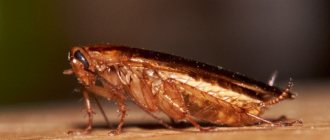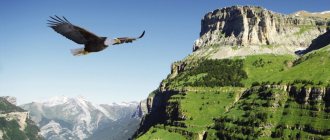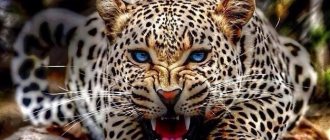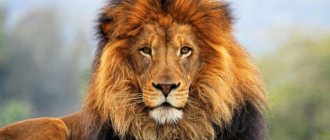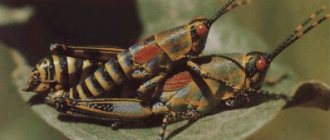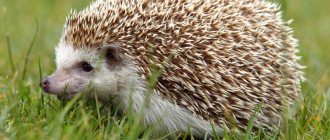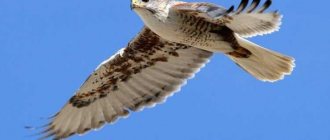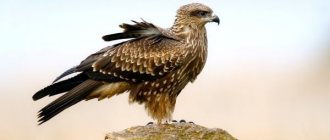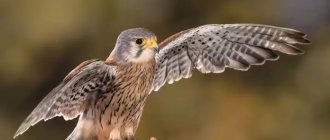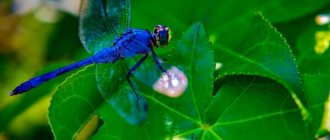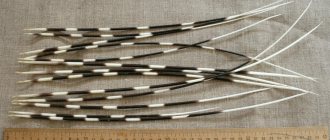Types of dragonflies in Russia and the CIS countries
- Common dragonfly , also known as Sympetrum vulgatum.
The most common, as the name suggests, is the dragonfly. Its wingspan is up to 6 cm, the length of its abdomen is up to 3 cm.
The color of the abdomen is yellow-brown (females) or reddish (males). The species is widespread throughout Europe, Africa and Asia, and is also found even in Siberia and the Far East.
- Beauty girl, aka Calopteryx virgo.
Length 4.5 - 5 cm, wingspan about 7 cm. Males are characterized by a bluish-blue or green-blue body color with a metallic tint. Females boast a bronze-green body with transparent wings.
In some regions of Russia it is listed in the Red Book.
- Emperor Watcher, aka Anax imperator.
The largest dragonfly in terms of wingspan in the post-Soviet space. The wingspan of an adult is about 11 cm. The species is listed in the Red Book, as it is on the verge of extinction.
Moreover, it is steadily declining in Russia. The reason for this is the human impact on the environment (water pollution). In western Europe and northern Africa, the number of the species is much higher. Belongs to the rocker family.
- Bolton's Macebelly, also known as Cordulegaster boltonii.
The body length of this dragonfly reaches 9 cm. The wingspan is 10.5 cm.
Representatives of this species are distinguished by their black coloration with bright yellow stripes. The dragonfly's wings are transparent with black veins. Interestingly, the female drops her eggs into the pond while flying.
- The headstock is metallic, also known as Somatochlora metallica.
The body length of this heteropterous dragonfly species is from 4 to 5.5 cm.
The eyes are green, the body also has a green color with a metallic tint. The most numerous species in the CIS and Europe. There are yellow spots on the abdominal segments.
- Common Grandfather, also known as Gomphus vulgatissimus.
A multi-winged dragonfly from the family of grandfathers. The wingspan is up to 7 cm, the body length is 4.5 - 5 cm. At the end of the abdomen there is a club-shaped thickening. Widely distributed throughout Europe and Central Asia.
The development cycle has more than 10 stages, females throw eggs into the water in flight.
Several more types of dragonflies:
The southern arrow, also known as Coenagrion mercuriale. A relict species, in some regions it is under threat of extinction.
Dryad lute , also known as Lestes dryas. This small (wingspan 3 cm) dragonfly is also included in the Red Book.
Habitat of the Overlord Watcher
Female Emperor's Watcher.
The range of this dragonfly is unusually wide, it covers almost all natural zones from South Africa to the Scandinavian Peninsula, but in most of the range the distribution of the species is local. In our country, imperial watchmen are found only in the south of the European part. To the north of the latitude of Moscow, these dragonflies are most likely known from their migrations, but they do not live there.
Description: What does a dragonfly look like?
Adults
- Slender, elongated body 20-130 mm long
- Head
- Breast
- 2 pairs of wings
- Three pairs of legs
The female and male often have different body and wing colors (sexual dichroism). The weight of an adult individual can vary depending on the species, for example, a very small individual weighs about 20 mg, and the “emperor watchman” species weighs about 1200 mg.
The insect's head is large, with huge eyes on the sides. It is very mobile and can rotate 180 degrees and tilt back 70 degrees. Compound eyes may consist of 28,000 “facets” (ommatidia).
In addition to compound eyes, the dragonfly also has three simple eyes that form a triangle. This structure allows the dragonfly to see not only forward, but also to the sides and even behind itself.
- The upper part of the compound eye of the dragonfly sees at a distance, and the lower part perceives closer objects. The visual range of compound eyes is approximately 8 meters.
- The thorax is characteristic of all insects and consists of a prothorax with two limbs, as well as a mesothorax and metathorax with four legs.
- Males have forceps on their abdomen, which they use to hold the female during mating.
- These insects are voracious predators and are therefore armed with sharp teeth.
Wings of a dragonfly
The maximum wingspan of an adult dragonfly can reach 18-20 cm. The wings consist of chitin with a complex structure that allows the insect to easily maneuver during flight. The maximum speed of a dragonfly is comparable to the speed of modern drones: 55-57 km/h.
Muse of Sikorsky
But it was precisely its ability to hover in the air for a long time (looking for prey) that served as the idea for creating a helicopter. The world-famous aircraft designer Igor Sikorsky designed his single-rotor helicopter by observing the flight of a dragonfly. Thousands of photographs of this insect helped to create a model in the computer that copies its maneuvers.
The dragonfly's body has a screw structure, as if covered with metal. The wings are arranged crosswise and have small thickenings - wing ocelli, or pterostigmas. They help avoid vibration during flight. Aviation designers use a similar design on airplanes to prevent wings from breaking. Thanks to such aerodynamics, a dragonfly can lift 15 times its own weight into the air!
Another similarity with technology is the headlight eyes.
The dragonfly's eyes are considered to be the most complex eye structure of any insect in the world. They take up half of her head and give her a nearly 360-degree view! The dragonfly can even see what is behind. That’s why it’s so difficult to get to her with a net.
But the dragonfly cannot boast of an excellent sense of smell: it only senses certain odors.
How is a dragonfly born?
Nymphs
Dragonflies develop through imperfect transformation, that is, their development does not include the pupal stage. Dragonfly nymphs (larvae) are born in or near water from eggs. If the egg does not overwinter, then the nymph hatches from it in two to four weeks.
The first stage of "pronymph" lasts only a few minutes. It does not yet look much like a dragonfly until the “undressing” occurs. After this, the first common features begin to appear.
The nymph undresses approximately 10-15 times, and with each undressing she sheds all her skin along with the respiratory and digestive tract. The nymph develops from several months to several years, and in some species up to 5 years.
Before the last undressing, the nymph stops receiving food and rises into the air, most often onto plant stems, sometimes directly to the shore. Hatching occurs most often in warm weather in the morning.
The nymph clings tightly to the substrate and begins to hatch. This process takes about an hour. After hatching, the dragonfly sits for a while, spreads its wings and freezes before it can fly away. Sexual maturity (by species) reaches from 14 days to a month.
Butterfly nymphs can restore lost organs (regenerate).
Eggs
Dragonfly eggs range from 0.5 to 2 mm in length. Species that lay eggs in plants have an elongated egg shape, while species that lay eggs freely have a round shape with a gelatinous coating.
Lifestyle
Insects are excellent flyers; they can reach speeds of up to 55-60 km/h. Their flight is characterized by planning. While looking for prey, dragonflies are able to hover in the air for a while. They fly several kilometers in search of comfortable habitats. Dragonflies are active during the daytime. They love warm sunny days. On a cool morning, adults can be seen basking in the rays of the rising sun. The great rocker is one of the species that are active not only during the day, but also after sunset. They spend the night on the treetops. The adult summer period is from July to September.
Dragonflies are reliable human assistants in the fight against blood-sucking insects. Adults destroy mosquitoes and gadflies on land, and nymphs destroy mosquitoes in bodies of water where pests lay eggs. In a swift flight, dragonflies in flight grab flies and mosquitoes with their paws, and can catch a butterfly or even a small dragonfly.
The larvae thrive in stagnant or low-flowing water with a large number of plants. Weak limbs prevent nymphs from traveling and pursuing prey. They hunt from ambush. During the throw, the larva releases a stream of water, which sharply throws it forward towards the prey. Its breathing mechanism is designed so that the tracheal gills are located in the rectum. The nymph swallows a large amount of water and receives oxygen, the liquid is excreted through the anus. To capture prey, the larvae have a special organ called a mask. This is a modified lower lip, equipped with a movable joint and grasping teeth.
After 2 years of development, the larva moves to land, where it settles on a vertical surface for its final transformation. Her skin dries out and cracks on her back. A dragonfly emerges from the old, tight skin. Her wings are soft and unformed. They wait for several hours for their wings to spread and harden. The final coloring takes several days to complete.
What does a dragonfly eat?
Dragonflies and their nymphs feed exclusively on prey. They usually hunt prey in flight, but some species wait in place and take off after prey only when they see it.
Particularly large dragonflies often devour their prey in flight. Thanks to their excellent vision, they can see prey at a distance of up to 2-6 meters. They first grab the prey with their legs, then pull it towards their mouth. Their prey is usually any flying insects, sometimes other types of dragonflies (often a dragonfly catches a butterfly).
The nymph hunts with the help of a so-called mask, which is a reshaped lower muzzle with a grasping device. She can extend the mask up to a third of her body and use it to drag prey to her mouth. Most often they prey on the larvae of other aquatic insects.
Leucorrhinia dubia
The dubious whitebill lives in peat bogs from northern Europe to Siberia. In Russia you can find it almost everywhere, with the exception of the Far East.
The dragonfly has a white muzzle, the top of its abdomen is covered with juicy spots of tangerine color. Grows no more than 3.6 cm.
Reproduction
The male dragonfly has two copulatory organs. The primary one, in which the sperm is stored, and the secondary one, located on the abdominal side of the second segment, which is needed directly for mating. Before copulation, the male must transfer sperm from the primary organ to the secondary organ.
Then he grabs the female by the head using pincers at the end of the headboard. During copulation, the female curls the end of her buttock towards the male's secondary reproductive organ. If the female has already been fertilized by another male before copulation, then the male removes his sperm from the genital opening with a sharp flagellum at the end of the penis.
The female lays eggs, often in the company of the male, who holds her with pincers. She lays her eggs differently depending on the species, sometimes directly into the water, into aquatic plants, or onto trees above the water. In some species (order Lepidoptera), when laying eggs, the female, together with the male, descends under water in an air bubble (for example, an annular core).
Underwater, they can descend to depths approaching one meter and remain there for up to one hour. Dragonflies, when laying eggs above the surface of the water, are guided by its shine in the sun, so sometimes they can lay eggs on the shiny body of a car.
Reproduction of dragonflies
Ophiogomphus cecilia
The horned grandfather can reach 5.8 cm. An olive-colored dragonfly with black rings on its abdomen. The name was given because of the growths on the head that resemble horns.
They are also called horned snake eaters. They live in Eurasia. They prefer the banks of quiet rivers and streams. They have individual hunting grounds.
Insect nutrition
Due to the fact that dragonflies are predators, they capture their prey in flight. All individuals have their own lands. In the process of life, they are engaged in their defense from foreign flying insects, and, if necessary, protect it.
What do dragonflies eat? They most often consume flying insects. Large breeds can eat small fish, as well as spiders or even frogs.
The dragonfly larva (naiad) feeds mainly on fish fry, small insects in the water, and their larvae. This diet is characterized by an aquatic living environment. In addition, they are engaged in cleaning the reservoir from various kinds of remains.
